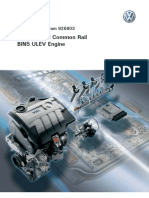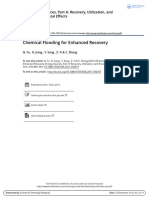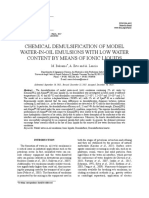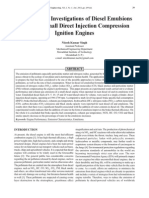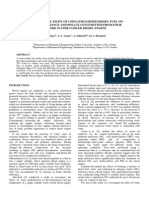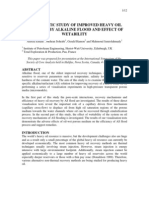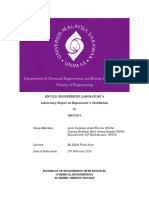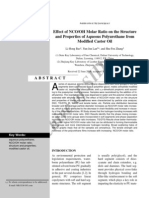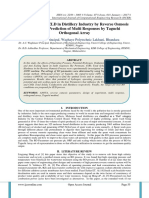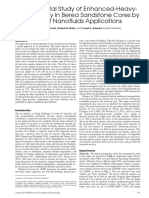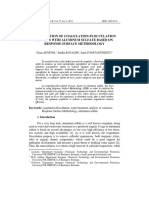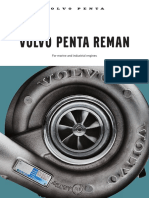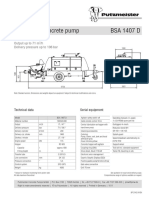20-80% Water-In-Diesel Emulsion Fuel Formulations and Stability Study For Duration of Two Weeks
20-80% Water-In-Diesel Emulsion Fuel Formulations and Stability Study For Duration of Two Weeks
Uploaded by
EvaPuspitaSariOriginal Description:
Original Title
Copyright
Available Formats
Share this document
Did you find this document useful?
Is this content inappropriate?
Report this DocumentCopyright:
Available Formats
20-80% Water-In-Diesel Emulsion Fuel Formulations and Stability Study For Duration of Two Weeks
20-80% Water-In-Diesel Emulsion Fuel Formulations and Stability Study For Duration of Two Weeks
Uploaded by
EvaPuspitaSariCopyright:
Available Formats
ISSN 2320-5407
International Journal of Advanced Research (2015), Volume 3, Issue 7, 1394-1398
Journal homepage: http://www.journalijar.com
INTERNATIONAL JOURNAL
OF ADVANCED RESEARCH
RESEARCH ARTICLE
20-80% water-in-diesel emulsion fuel formulations and stability study for duration of two
weeks
Souleyman A. Issaka, Abdurahman H. Nour, and Rosli M. Yunus
Faculty of Chemical and Natural Resources Engineering University Malaysia Pahang 12, 25000, Kuantan, Pahang,
Malaysia
Manuscript Info
Abstract
Manuscript History:
New surfactant formulations were prepared at FKKSA Lab at University
Malaysia Pahang; the formulation consists of synthesized polyol based nonionic surfactants combined with different concentrations of commercial
stabilizers and co surfactants. Six different compositions denoted as Samples
(A, B, C, D, E, F) were tested on 20-80% water-in-diesel emulsion fuel
samples for duration of fortnights. Results showed that emulsions prepared
with formulations C, D, E and F were very stable and showed no water
separation for two weeks. Followed by B, which started separation after 13
days and lost 15% of the water, while sample A, which appeared to be the
least stable of all, lost 15% of oil in the first day. From these data one can
conclude that the samples (C, D, E and F) surfactant formulation could be
used as tailored stabilizers for synthesizing diesel based emulsion fuels.
Received: 14 May 2015
Final Accepted: 19 June 2015
Published Online: July 2015
Key words:
Stabilizers, Emulsion fuel, water-indiesel
emulsions,
nonionic
surfactants
*Corresponding Author
Souleyman A. Issaka
Copy Right, IJAR, 2015,. All rights reserved
INTRODUCTION
With ever-increasing environmental concerns on pollutant emissions of diesel fueled machineries, there have been a
lot of concerns on techniques and ways that could abate the emission of toxic gases without altering the performance
and combustion effectiveness of diesel based internal combustion engines. One of the very sustainable solutions is
the emulsion fuel, which is produced via mixing water and fossil diesel (Jae W. Park, Kang Y. 2000). The massive
emission of greenhouse gases as result of human activities is claimed to be responsible for sever changes in the
ecosystem. Thus, including rise of ocean level, flooding, drought, decreasing snow and ice covers. Around 60% of
the greenhouse gases are produced from the fossil based fuel combustion that is largely emitted from industries and
transportation (Ahmad Muhsin Ithnin et al., 2014). Although diesel engines (combustion ignition engines) are
widely used worldwide because of their massive power output and lower fuel consumption, yet, they are not
sustainable from environmental perspectives, that is because they are responsible for emitting massive amounts of
nitrogen oxides (NOx) and particulate matters (PM) (Ahmad Muhsin Ithnin et al., 2014).
The importance of using emulsified fuel relays mainly on its ability to reduce unwanted combustion products such
oxides of nitrogen and particulate matter form diesel fueled machineries (Omar Badran et al., 2011).
Injection of water through the engine injector was found to decrease nitrous oxides (NOx) and smoke (Patricia A.
Strandell and henry W.schab 1986), Some emulsified fuels were able to reduce the sulfur content in higher sulfur
fuels, thus, adding soda ash to the emulsifying water had reduced the smoke emissions by as much as 50% (Patricia
A. Strandell and henry W.schab, 1986).
1394
ISSN 2320-5407
International Journal of Advanced Research (2015), Volume 3, Issue 7, 1394-1398
During the combustion process, water causes the fuel atomization, which results from the occurrence of the microexplosion, a process through by the water droplets, which normally evaporate at 100 C causes explosion that
exceeds the interfacial tension between the fuel and water vapor leading to better fuel air mixture. Water also causes
ignition delay during combustion, which leads to increase in pressure rise within the engine cylinder, increasing
thermal efficiency and reduces thermal stress within the engine components. During the combustion process, the
elevated level of micro-explosion is witnessed by the reduction of flame height to be more intense around its axis.
The NOx reduction process is governed by the elevated local excess air factor due to the manifestation of larger and
denser water droplets (Ali M.A. Attia et al, 2014). Micro-explosion occurs because of the differences in boiling
points between the continuous phase (oil) and dispersed phase (water). In a typical water-in-oil emulsion fuel sample
introduced to a combustor the oil plus surfactant encapsulated water droplets are heated due to the elevated air
temperature (in combustion chamber), and since water have lower boiling point it can be overheated and starts to
boil inside the oil capsules, this state is referred to as metastable and water would boil vigorously. Soon after this
vigorous boiling, water would cause explosion of the encapsulating parent oil layer of the droplet. This is known as
explosive boiling of micro-explosion phenomena which almost always encountered in the combustion of emulsion
fuel (J. Shinjo, J. Xia et al., 2014). Currently, researchers are embarked more than ever before in the emulsion fuel
related subjects because of its potential advantage as alternative and sustainable fuel. Kajima and colleagues have
studied the effect of ultrasonic emulsification techniques in the stability of water-in-diesel emulsion. They have
studied the effect of the ultrasonic horn tip position in the sample, emulsification time (mixing time), and water
content by measuring viscosity, droplet sizes and droplet surface area of the produced emulsion (Kojima Y, Imazu H
et al., 2013). Yang and colleagues have synthesized very stable nano-emulsion fuel sample consisting of 5% by
volume water, 12.6% by volume nano-organic additives and the rest is diesel. The nono-organic additive sample
consisted of water soluble oxygenates including glycerin, polyethoxyester and water soluble nonionic surfactants
(e.g. nonylphenolethoxylte). They also found that emulsion fuel viscosity is higher than that of the original emulsion
and decrease rapidly with increasing temperature. (W.M.Yang, H. An et al., 2013). Owing to the storage and
marketability criterion, a good emulsion fuel must be stable at least for one week (10,000 hours). Andrew Simon and
co-researchers have incorporated the water soluble polymeric nonionic surfactants such as polyhydric alcohols and
ethoxylated fatty acid esters in the surfactant formulation. Their surfactant concentration was as high as 4% and
water content of 25% (Andrew Simon et al., 2010). Others have created and tested emulsion fuel with 7.5% water
using span-20 and tween-20 as emulsifiers, their study revealed that emulsion fuel causes slight decrease in break
specific fuel consumption of the engine and increased the break thermal efficiency (Hrishikesh et al., 2014). Similar
results were reported by R.venkatesh and colleagues who synthesized emulsion fuel via mixing aqueous metal
solution, diesel oil, surfactants, and water. The concentration of the aqueous solution was 10% (0.4% mol/dm3
mixture of salt and distilled water), tween 80 was used as emulsifiers at 1% concentration, the total emulsification or
mixing time was 45 minutes. Although many technologies and methods of synthesizing emulsion fuel have been
introduced, yet, very few studies were conducted regarding the stability and shelf life aspects of emulsion fuel.
Therefore, this current study is aimed to assess the performance of newly formulated surfactants on stability of
emulsion fuel for duration of two weeks.
Experimental procedures
in this study 6 different formulations were tested, the test was performed by preparing emulsions for each of these
six surfactant formulations and study the stability carefully by observing and recording the water separation from the
emulsions. The water separation was recorded every 24 hours (daily), for two weeks (14 days). Materials used in
this study were commercial diesel fuel which was purchased from local fuel station as oil or external phase, tap
water as aqueous phase, and the newly formulated emulsifiers which given the code names (SA, SB, SC, SD,SE and
SF), S is stand for sample (e.g. sample A(SA), Sample B (SB) and so on.
Results and discussions
Table 1: Rate of water separation from
stable emulsions of Samples (A, B and C)
Time
(days)
The amount Water and oil
separation with time (ml)
1395
ISSN 2320-5407
International Journal of Advanced Research (2015), Volume 3, Issue 7, 1394-1398
01
02
03
04
05
06
07
08
09
10
11
12
13
14
O
3
3
3
3
3
3
3
3
3
3
3
3
3
3
SA
W
0
0
0
0
0
0
0
0
0
5
6
6
6
6.5
SB
O W
0 0
0 0
0 0
0 0
0 0
0 0
0 0
0 0
0 0
0 0
0 0
0 0
0 3
0 3
SC
O W
0 0
0 0
0 0
0 0
0 0
0 0
0 0
0 0
0 0
0 0
0 0
0 0
0 0
0 0
Table 1 reveals the experimental results obtained from the stability study of three different emulsion fuel samples
denoted as (Samples (A, B and C)), the bold letters O and W on the table stand for oil and water respectively. As
depicted clearly on the table, samples C was more stable than the others, followed by sample B then sample C. Thus,
sample C does not show either oil or water separation within this designated period of two weeks. Meanwhile,
sample B emulsion had retained its water for 12 days without any separation, then a constant amount of water (3ml
or 15%) was resolved in days 13 and 14. However, sample 3 showed 3 ml (15%) separation from the day 1 and
stayed constant (3 ml) until day 14, while oil uptake of Sample A was very loose, yet its water uptake was quite firm
because water separation was observed only after day 11.
Figure 1: Samples of some selected pictures of emulsion fuels at different intervals
Figure 1 shows the pictures of the emulsion fuels samples (A, B and C) whose quantitative stability assessment was
given earlier in table 1 at different time intervals. Actually, these pictures show the visual changes in the emulsion
fuel color with time. It is a known fact that stable emulsion fuel should retain its water unresolved and its color
unchanged at least for one week. In figure 1, the letters A, B and C, refer to Samples (A, B and C) respectively while
the numbers (1, 7 and 14) refer to retention or stability time (days), thus, in figure 1, picture with label A1 means
emulsion prepared with Sample A surfactant formulation at it first day. Meanwhile, picture with label A7 means the
same sample (sample A) after one week (seven days), similarly, picture with label A14 was taken after 14 days (two
weeks).
Table 2: Quantitative monitoring of water separation
rate from stable emulsions prepared from Samples (D,E and F)
Time
(days)
01
02
The amount Water and oil
Separation with time (ml/day)
SD
SE
SF
O W O W O W
0
0
0
0
0
0
0
0
0
0
0
0
1396
ISSN 2320-5407
International Journal of Advanced Research (2015), Volume 3, Issue 7, 1394-1398
03
04
05
06
07
08
09
10
11
12
13
14
0
0
0
0
0
0
0
0
0
0
0
0
0
0
0
0
0
0
0
0
0
0
0
0
0
0
0
0
0
0
0
0
0
0
0
0
0
0
0
0
0
0
0
0
0
0
0
0
0
0
0
0
0
0
0
0
0
0
0
0
0
0
0
0
0
0
0
0
0
0
0
0
Table 2 shows the results of the stability test for three emulsion fuel samples prepared from Samples (D, E and F)
formulations. All the three samples showed zero separations, which indicate that there was neither oil nor water
separation at all within two weeks (14 days). This means, the samples (D, E and F) could produce quite stable
emulsion fuel; therefore, it might be a good candidate to be considered as potential emulsion fuel stabilizers.
Figure 2: Samples of some selected pictures of emulsion fuels at different intervals
Figure 2 shows some selected pictures of emulsion fuel samples whose quantitative results were given in table 2.
Labels on samples (D, E and F) represent the different formulations of the surfactant, as mentioned earlier, D1 refers
to emulsion fuel sample prepared from Sample D formulation and aged one day. D7 denotes the picture of the same
sample after 7 days and D14 after fortnight. Similarly, the labels E1, E7, E14 and F1, F7, F14 represents emulsion
fuel samples prepared using Samples E and F formulations at different intervals (1, 7, 14 days).
Conclusions
Polyol based surfactant was successfully synthesized and tested at university malaysia pahang (UMP), These
synthesized surfactants then combined with some commercial stabilizers and used to stabilize water-in-diesel
emulsions (emulsion fuel). Six different compositions of surfactants were produced, each given specific name as
sample A, sample B until sample F. The stability study was performed by reading the amount of water separated
from the emulsion in a daily basis for fortnights. Results showed that emulsions prepared with formulations C, D, E
and F were very stable and showed no water separation for two weeks. Followed by B, which started separation after
13 days and lost 15% of the water, while sample A, which appeared to be the least stable of all, lost 15% of oil in the
first day. From these data, one can conclude that the samples (C, D, E and F) surfactant formulation could be used as
tailored stabilizers for synthesizing diesel based emulsion fuels.
Acknowledgement
The authors would like to acknowledge the financial support from University Malaysia Pahang.
References
1397
ISSN 2320-5407
International Journal of Advanced Research (2015), Volume 3, Issue 7, 1394-1398
1.
Patricia A. Strandell and henry W.schab, a review of water emulsified fuel investigations for shipboard
applications, Naval engineering journal (1986); Page 53-69.
2.
Omar Badran, Sadeq Emeish, Mahmoud Abu-Zaid, Tayseer Abu-Rahma,Mohammad Al-Hasan, Mumin AlRagheb, Impact of water/diesel mixture on engine performance and environment (2011), international journal
of thermal and environmental engineering; 3:1-7
3.
Jae W. Park, Kang Y. Huh and Kweon H. Park, Experimental Study on the Combustion Characteristics of
Emulsified Diesel in a RCEM, Seoul 2000 FISITA World Automotive Congress, Seoul, Korea (2000),
F2000A073.
4.
Ahmad Muhsin Ithnin , Hirofumi Noge , Hasannuddin Abdul Kadir ,Wira Jazair, An overview of utilizing
water-in-diesel emulsion fuel in diesel engine and its potential research study, Journal of the Energy Institute
(2014); 87:273288
5.
Ali M.A. Attia , A.R. Kulchitskiy, Influence of the structure of water-in-fuel emulsion on diesel engine
performance, J. of Fuel (2014);116: 703708
6.
J. Shinjo, J. Xia, L. C. Ganippa, and A. Megaritis, Physics of puffing and microexplosion of emulsion fuel
droplets, Physics of Fluids (2014);26: 103302; doi: 10.1063/1.4897918
7.
Kojima Y, Imazu H, Nishida K., Physical and chemical characteristics of ultrasonically-prepared water-indiesel fuel: effects of ultrasonic horn position and water content, Ultrason Sonochem. (2014);2:722-8.doi:
10.1016/j.ultsonch.2013.09.019. Epub 2013 Oct 7
W.M. Yang , H. An, S.K. Chou, K.J. Chua, B. Mohan, V. Sivasankaralingam, V. Raman, A. Maghbouli, J. Li,
Impact of emulsion fuel with nano-organic additives on the performance
of diesel engine, Applied Energy (2013);112: 12061212
8.
9.
Andrew simon oldfield, saltburn by sea (GB), Lee thompson, Trimdon grange (GB), Diesel Fuel Emulsion,
United State Patent (2010), US 7,731 B2.
10. Hrishikesh Sane, Neil Purandare, Omkar Barve, Aakash Todakar, Emission reduction of ic engines by using
water -in-diesel emulsion and catalytic converter, International Journal of Research in Engineering and
Technology (2014); 03:378-383
11. By R.Venkatesh Babu , Dr.S.Sendilvelan, Reduction of Pollutants in CI Engine Using Emulsion Fuels To
Reduce Overall Traffic-Induced Emissions, Global Journal of Research Engineering (2011);11; ISSN: 09755861.
1398
You might also like
- Diesel Engine 2.0L TDI Common RailDocument90 pagesDiesel Engine 2.0L TDI Common Railsmcsosvas100% (9)
- Emulsion Polymerization of Vinyl Acetate, Ethylene, and N-Methylol AcrylamideDocument6 pagesEmulsion Polymerization of Vinyl Acetate, Ethylene, and N-Methylol Acrylamideramitkatyal21881No ratings yet
- 1 DIESEL EMISSIONS TECHNOLOGY Sulzer 33Document33 pages1 DIESEL EMISSIONS TECHNOLOGY Sulzer 33ZIBA KHADIBINo ratings yet
- Vta28 G5Document2 pagesVta28 G5singularlyattractive100% (3)
- Chemical Flooding For Enhanced Recovery: Energy Sources, Part A: Recovery, Utilization, and Environmental EffectsDocument7 pagesChemical Flooding For Enhanced Recovery: Energy Sources, Part A: Recovery, Utilization, and Environmental EffectsWan Nur ShabiraNo ratings yet
- Impact of Emulsified Water/Diesel Mixture On Engine Performance and EnvironmentDocument7 pagesImpact of Emulsified Water/Diesel Mixture On Engine Performance and Environmentdipali2229No ratings yet
- Demulsif SaltDocument12 pagesDemulsif SaltLidiya KirilovaNo ratings yet
- Energy Conversion and Management: A. Alahmer, J. Yamin, A. Sakhrieh, M.A. HamdanDocument6 pagesEnergy Conversion and Management: A. Alahmer, J. Yamin, A. Sakhrieh, M.A. Hamdandipali2229No ratings yet
- Chemical Demulsification of Model Water-In-Oil Emulsions With Low Water Content by Means of Ionic LiquidsDocument10 pagesChemical Demulsification of Model Water-In-Oil Emulsions With Low Water Content by Means of Ionic LiquidsoreamigNo ratings yet
- Made Suarta 2018 J. Phys. Conf. Ser. 953 012070Document7 pagesMade Suarta 2018 J. Phys. Conf. Ser. 953 012070feronica chungNo ratings yet
- A Comprehensive Evaluation of Alkaline Surfactant Polymer Flooding and Hybrid Process For Enhanced Oil RecoveryDocument40 pagesA Comprehensive Evaluation of Alkaline Surfactant Polymer Flooding and Hybrid Process For Enhanced Oil RecoveryAsim MemonNo ratings yet
- SPE-182836-MS Simulation of Ionic Liquid Flooding For Chemical Enhance Oil Recovery Using CMG STARS SoftwareDocument14 pagesSPE-182836-MS Simulation of Ionic Liquid Flooding For Chemical Enhance Oil Recovery Using CMG STARS SoftwareVeronicaNo ratings yet
- Literature ReviewDocument4 pagesLiterature ReviewShakeel Ahmed100% (1)
- Applied Energy: M. Husnawan, H.H. Masjuki, T.M.I. Mahlia, M.G. SaifullahDocument7 pagesApplied Energy: M. Husnawan, H.H. Masjuki, T.M.I. Mahlia, M.G. SaifullahMuhammad Imran KhanNo ratings yet
- Heavy-Oil-Recovery Enhancement With Choline Chloride Ethylene Glycol-Based Deep Eutectic SolventDocument9 pagesHeavy-Oil-Recovery Enhancement With Choline Chloride Ethylene Glycol-Based Deep Eutectic Solventirfan100% (1)
- PHD / Master'S Degree by Research: Assignment Cover SheetDocument10 pagesPHD / Master'S Degree by Research: Assignment Cover SheetIra HaiNo ratings yet
- Numerical Simulation of The Performance Parameters of A Spark Ignited Engine Running On Ethanol at Different Percentages of HydrationDocument4 pagesNumerical Simulation of The Performance Parameters of A Spark Ignited Engine Running On Ethanol at Different Percentages of HydrationThompson LanzanovaNo ratings yet
- The Impacts of Water Injection Application On The Performance of Internal Combustion EnginesDocument7 pagesThe Impacts of Water Injection Application On The Performance of Internal Combustion EnginesJohn VlahidisNo ratings yet
- Stability Behavior of Water-in-Diesel Fuel Emulsion: M. T. Ghannam and M. Y. E. SelimDocument16 pagesStability Behavior of Water-in-Diesel Fuel Emulsion: M. T. Ghannam and M. Y. E. Selimdipali2229No ratings yet
- Emulsification Characteristics of Three-And Two-Phase Emulsions Prepared by The Ultrasonic Emulsification MethodDocument9 pagesEmulsification Characteristics of Three-And Two-Phase Emulsions Prepared by The Ultrasonic Emulsification MethodAD OLofloveNo ratings yet
- Experimental Investigations of Diesel Emulsions As Fuel in Small Direct Injection Compression Ignition EnginesDocument6 pagesExperimental Investigations of Diesel Emulsions As Fuel in Small Direct Injection Compression Ignition Enginesdipali2229No ratings yet
- SPE-176465-MS Experimental Investigation of Crude Oil Emulsion Physicochemical Properties and Demulsifier Dosage PredictionDocument24 pagesSPE-176465-MS Experimental Investigation of Crude Oil Emulsion Physicochemical Properties and Demulsifier Dosage PredictionGabriel EduardoNo ratings yet
- A Comparative Research of Microwave Conventional Heating and Microwave Chemical Demulsification of Tahe Heavy Oil in Water EmulsionDocument11 pagesA Comparative Research of Microwave Conventional Heating and Microwave Chemical Demulsification of Tahe Heavy Oil in Water EmulsionIbraheem SalaudeenNo ratings yet
- Droplet Size Dependent Solubilization and Crystallization of Lipids in Oil-In-Water EmulsionDocument11 pagesDroplet Size Dependent Solubilization and Crystallization of Lipids in Oil-In-Water EmulsionCynthia Cano SarmientoNo ratings yet
- Experimental Study of Using Emulsified Diesel Fuel On The Performance and Pollutants Emitted From Four Stroke Water Cooled Diesel EngineDocument5 pagesExperimental Study of Using Emulsified Diesel Fuel On The Performance and Pollutants Emitted From Four Stroke Water Cooled Diesel Enginedipali2229No ratings yet
- Mechanistic Study of Improved Heavy Oil Recovery by Alkaline Flood and Effect of WetabilityDocument12 pagesMechanistic Study of Improved Heavy Oil Recovery by Alkaline Flood and Effect of WetabilityRosa K Chang HNo ratings yet
- J Ces 2018 05 033Document31 pagesJ Ces 2018 05 033RAHMANSYAH RAHMANSYAHNo ratings yet
- SPE 153866 Microbial EOR: A Quantitative Prediction of Recovery FactorDocument10 pagesSPE 153866 Microbial EOR: A Quantitative Prediction of Recovery FactorSajad FalahNo ratings yet
- Introduction (Distillation)Document2 pagesIntroduction (Distillation)Raffandi RolandoNo ratings yet
- Computers and Chemical Engineering: E. Quijada-Maldonado, G. Wytze Meindersma, André B. de HaanDocument10 pagesComputers and Chemical Engineering: E. Quijada-Maldonado, G. Wytze Meindersma, André B. de HaanWilo JaraNo ratings yet
- Combustion Characterization in A Single Cylinder Engine With Mid Level Hydrated Ethanol Gasoline Blended Fuels 2013 Fuel 1Document7 pagesCombustion Characterization in A Single Cylinder Engine With Mid Level Hydrated Ethanol Gasoline Blended Fuels 2013 Fuel 1Anita GaileNo ratings yet
- Microemulsions A Novel Approach To Enhanced Oil Recovery A ReviewDocument15 pagesMicroemulsions A Novel Approach To Enhanced Oil Recovery A ReviewLindaNathalieSuarezPiñerezNo ratings yet
- Simulation of O/W Emulsion Flow in Alkaline/Surfactant Flood For Heavy Oil RecoveryDocument13 pagesSimulation of O/W Emulsion Flow in Alkaline/Surfactant Flood For Heavy Oil Recoverylulalala8888No ratings yet
- Literature ReviewDocument13 pagesLiterature ReviewHasmadi HassimNo ratings yet
- Experiment 2Document14 pagesExperiment 2shathishNo ratings yet
- Structured Polyvinyl AlcoholZeoliteCarbon CompositDocument11 pagesStructured Polyvinyl AlcoholZeoliteCarbon CompositFarah TalibNo ratings yet
- Effect of Ultrasonic at Ion On Droplet Size in Biodiesel Mixtures - Grulke (Purchased SpringerLinkDocument8 pagesEffect of Ultrasonic at Ion On Droplet Size in Biodiesel Mixtures - Grulke (Purchased SpringerLinkhaoquiNo ratings yet
- Accepted Manuscript: Undogan Kalat, Ahmet Y UceerDocument26 pagesAccepted Manuscript: Undogan Kalat, Ahmet Y Uceeranca panaNo ratings yet
- Experimental Study and Pilot Test of Urea - and Urea-And-Foam-Assisted SteamDocument8 pagesExperimental Study and Pilot Test of Urea - and Urea-And-Foam-Assisted Steamfernando aguilarNo ratings yet
- Evaluating The Performance of Ultrasound Energy OnDocument16 pagesEvaluating The Performance of Ultrasound Energy Onals.persia.sa061No ratings yet
- Inhibition of Scale Buildup During Produced Water Reuse Optimization of Inhibitors and Application in The Field 2014 DesalinationDocument7 pagesInhibition of Scale Buildup During Produced Water Reuse Optimization of Inhibitors and Application in The Field 2014 DesalinationLaisa Candido MaiaNo ratings yet
- Effect of NCO and OH Molar RatioDocument10 pagesEffect of NCO and OH Molar RatioUsama AwadNo ratings yet
- SPE-188174-MS Green EOR Utilizing Well-Defined Nano-Cellulose Based Nano-Fluids From Flask To FieldDocument13 pagesSPE-188174-MS Green EOR Utilizing Well-Defined Nano-Cellulose Based Nano-Fluids From Flask To FieldJosé Manuel UsuriagaNo ratings yet
- Hybrid Enhanced Oil RecoveryDocument41 pagesHybrid Enhanced Oil Recoveryintelligent207No ratings yet
- Optimization of ZLD in Distillery Industry by Reverse Osmosis Process For Prediction of Multi Responses by Taguchi Orthogonal ArrayDocument12 pagesOptimization of ZLD in Distillery Industry by Reverse Osmosis Process For Prediction of Multi Responses by Taguchi Orthogonal ArrayInternational Journal of computational Engineering research (IJCER)No ratings yet
- Ijmet 10 01 059Document23 pagesIjmet 10 01 059IAEME PUBLICATIONNo ratings yet
- Improving Condensate Recovery Using Water Injection Model at Dew-Point PressureDocument9 pagesImproving Condensate Recovery Using Water Injection Model at Dew-Point PressureAJER JOURNALNo ratings yet
- Biglari2010 PDFDocument12 pagesBiglari2010 PDFJAIDEEP VAIDYANo ratings yet
- Esterification of Acetic Acid Via Semi-Batch Reactive Distillation For Pyrolysis Oil Upgrading: Experimental ApproachDocument8 pagesEsterification of Acetic Acid Via Semi-Batch Reactive Distillation For Pyrolysis Oil Upgrading: Experimental ApproachYanin CyrusNo ratings yet
- Practical Kinetic Coupling To Multi-Component and Multi-Phase FlowDocument16 pagesPractical Kinetic Coupling To Multi-Component and Multi-Phase FlowSopan Ram TambekarNo ratings yet
- Trab NakaDocument8 pagesTrab NakaGabriel ChagasNo ratings yet
- Petroleum: Sadegh Keshtkar, Morteza Sabeti, Amir H. MohammadiDocument10 pagesPetroleum: Sadegh Keshtkar, Morteza Sabeti, Amir H. MohammadiRonald NgueleNo ratings yet
- Eor Shale Co2Document8 pagesEor Shale Co2Anand SelveindranNo ratings yet
- Experimental Study of Enhanced-Heavy-Oil Recovery in Berea Sandstone Cores by Use of Nanofluids ApplicationsDocument13 pagesExperimental Study of Enhanced-Heavy-Oil Recovery in Berea Sandstone Cores by Use of Nanofluids ApplicationsAnand aashishNo ratings yet
- Pilot Plant Validation of A Rate-Based Extractive DistillationDocument11 pagesPilot Plant Validation of A Rate-Based Extractive DistillationJenifer NiñoNo ratings yet
- Flooding Polymer EORDocument14 pagesFlooding Polymer EORximenaesgNo ratings yet
- Effect of Operating Conditions On The Solvent Recovery by The Method of EvapoDocument6 pagesEffect of Operating Conditions On The Solvent Recovery by The Method of EvapoIAEME PublicationNo ratings yet
- Spe113510 PDFDocument10 pagesSpe113510 PDFعبدالغفار بيزانNo ratings yet
- Catalizatori Eterogeni Pentru Productia de BiodieselDocument4 pagesCatalizatori Eterogeni Pentru Productia de BiodieselElly GloriaNo ratings yet
- International Journal of Sustainable EnergyDocument10 pagesInternational Journal of Sustainable Energydipali2229No ratings yet
- Selection Method of Surfactants For Chemical Enhanced Oil RecoveryDocument8 pagesSelection Method of Surfactants For Chemical Enhanced Oil RecoveryAdhita MeryantoNo ratings yet
- Oil Spill Remediation: Colloid Chemistry-Based Principles and SolutionsFrom EverandOil Spill Remediation: Colloid Chemistry-Based Principles and SolutionsNo ratings yet
- Fuels, Chemicals and Materials from the Oceans and Aquatic SourcesFrom EverandFuels, Chemicals and Materials from the Oceans and Aquatic SourcesFrancesca M. KertonNo ratings yet
- Pharmanest: Original Research PaperDocument12 pagesPharmanest: Original Research PaperEvaPuspitaSariNo ratings yet
- Pharmanest: Original Research PaperDocument12 pagesPharmanest: Original Research PaperEvaPuspitaSariNo ratings yet
- Full 66817Document8 pagesFull 66817EvaPuspitaSariNo ratings yet
- A Greatly Under-Appreciated Fundamental Principle of Physical Organic ChemistryDocument17 pagesA Greatly Under-Appreciated Fundamental Principle of Physical Organic ChemistryEvaPuspitaSariNo ratings yet
- LEADING ARTICLE Insulin Resistance As A Predictor of Worsening of Glucose Tolerance in Type 2 DMDocument6 pagesLEADING ARTICLE Insulin Resistance As A Predictor of Worsening of Glucose Tolerance in Type 2 DMEvaPuspitaSariNo ratings yet
- Karakterisasi Hasil Perlakuan Kimia Alkali X%Naoh Terhadap Topografi Permukaan, Kekuatan Tarik Dan Model Patahan Serat Tunggal Rami (Boehmeria Nivea)Document8 pagesKarakterisasi Hasil Perlakuan Kimia Alkali X%Naoh Terhadap Topografi Permukaan, Kekuatan Tarik Dan Model Patahan Serat Tunggal Rami (Boehmeria Nivea)EvaPuspitaSariNo ratings yet
- C87 ENT DS Tier3 P2G04C007E PDFDocument4 pagesC87 ENT DS Tier3 P2G04C007E PDFTaha RdmanNo ratings yet
- Main Idea (Ereading Worksheet)Document14 pagesMain Idea (Ereading Worksheet)Rinda RiztyaNo ratings yet
- Volvo RemanDocument72 pagesVolvo Remanrizki hidayat100% (1)
- Best Major ProjectsDocument3 pagesBest Major ProjectsTanu RdNo ratings yet
- Product Guide: Regulateurs EuropaDocument13 pagesProduct Guide: Regulateurs EuropaFernando AlegriaNo ratings yet
- Industrial Diesel Generator Set - 50 HZ - Emission Optimized - EPA Tier 2 CompliantDocument8 pagesIndustrial Diesel Generator Set - 50 HZ - Emission Optimized - EPA Tier 2 CompliantXuân Huy NguyễnNo ratings yet
- Technical File d11-mp (Tierii) - GL - E3 - 03Document10 pagesTechnical File d11-mp (Tierii) - GL - E3 - 03ArielNo ratings yet
- Construction of Automotive EngineDocument55 pagesConstruction of Automotive EngineArindom NagNo ratings yet
- TCA Project Guide - Document - MAN Diesel & TurboDocument120 pagesTCA Project Guide - Document - MAN Diesel & TurboOxsidays 13No ratings yet
- Ford DEF Service InfoDocument17 pagesFord DEF Service InfoABBA Plant100% (1)
- Stationary Concrete Pump BSA 1407 D: Output Up To 71 M /H Delivery Pressure Up To 106 BarDocument1 pageStationary Concrete Pump BSA 1407 D: Output Up To 71 M /H Delivery Pressure Up To 106 BarJing AytonaNo ratings yet
- Combustion Modeling of Dual-Fuel Engines - 2Document2 pagesCombustion Modeling of Dual-Fuel Engines - 2helenNo ratings yet
- Engine ClassificationDocument13 pagesEngine Classificationa7med SoulimanNo ratings yet
- 10.machine Design - Lab Manual 12.08.2017 PDFDocument14 pages10.machine Design - Lab Manual 12.08.2017 PDFDhruvil PatelNo ratings yet
- 44.al Si MG Pin FinDocument73 pages44.al Si MG Pin FineshuNo ratings yet
- Wajih Abbas: Personal InformationDocument2 pagesWajih Abbas: Personal InformationNisha zehraNo ratings yet
- Citroën Nemo (2010 - 2015) - Fuse Box DiagramDocument3 pagesCitroën Nemo (2010 - 2015) - Fuse Box DiagramOvo BabaAzizi OvoNo ratings yet
- Diesel Generator Set: Output RatingsDocument9 pagesDiesel Generator Set: Output Ratingsmpveravi0% (1)
- Trident PVT LTD 3Document17 pagesTrident PVT LTD 3Shreya JoriNo ratings yet
- Esab Edw 510D-3Document2 pagesEsab Edw 510D-3Allia AliNo ratings yet
- Ad 220 EuDocument6 pagesAd 220 EuomarNo ratings yet
- WFMDocument44 pagesWFMedima79No ratings yet
- Oem Sale Sheet ManDocument4 pagesOem Sale Sheet ManSanogo YayaNo ratings yet
- Ece Lab Manual - MiteDocument44 pagesEce Lab Manual - MiteSubuddhi DamodarNo ratings yet
- 3 KKS For GT13,14Document6 pages3 KKS For GT13,14md abNo ratings yet
- Cummins Accesorios Compresores Portatiles PDFDocument301 pagesCummins Accesorios Compresores Portatiles PDFFabricio Jiménez T100% (1)
